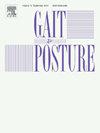年轻足球运动员的有氧运动能力与脊柱弯曲和活动度之间的关系
IF 2.2
3区 医学
Q3 NEUROSCIENCES
引用次数: 0
摘要
研究背景关于足球运动中的伤病和表现方面的研究很多,如今,有氧运动能力、脊柱姿势和活动度已被分别纳入表现的考虑范围。从生物力学的角度考虑,我们认为脊柱弯曲度和活动度可能会影响有氧运动表现,并调查了它们之间的关系。研究问题年轻足球运动员的节段性脊柱弯曲度和活动度是否会影响他们的有氧能力和最大运动表现?方法34 名年轻联赛球员(平均年龄 16.56 ± 1.11 岁)在赛季前接受了评估。使用无创计算机辅助机电设备进行矢状面脊柱评估,并使用心肺运动测试设备进行有氧能力评估。脊柱姿势变量与有氧运动能力之间的关系采用皮尔逊相关分析法,简单线性回归分析法用于估计脊柱弯曲度和活动度对有氧运动能力的影响。最大摄氧量(VO2max)和最大心率(HRmax)与胸椎角度呈负相关(分别为r=-0.343,p=0.047和r=-0.344,p=0.046)。胸廓角度还与潮气量(VT)和 VO2/HR 相关(分别为 r=-0.347,p=0.044 和 r=-0.348,p=0.044)。胸廓活动度越高,达到无氧阈值(VAT)的时间越早(r=-0.368,p=0.032),速度越低(r=-0.367,p=0.033)。在其他区段,腰部活动度与 VAT 的 VT 呈负相关(r=-0.346;p=0.045),而脊柱倾斜度与 VAT 的 HR 呈负相关(r=-0.387,p=0.024)。脊柱弯曲度和活动度,尤其是胸椎部位的弯曲度和活动度,可能会影响足球运动员的有氧运动能力。训练员不仅要考虑足球运动员的技战术表现,还要考虑他们的总体表现。本文章由计算机程序翻译,如有差异,请以英文原文为准。
The association between aerobic capacity and spinal curvature and mobility in young soccer players
Background
There is a lot of research in terms of injuries and performance in football and nowadays aerobic capacity, spinal posture and mobility have been taken into consideration separately in terms of performance. Considering from a biomechanical perspective, we thought spinal curvature and mobility may affect aerobic performance and investigated the relationship between them.
Research question
Do young soccer players' segmental spinal curvature and mobility affect their aerobic capacity and maximal exercise performance?
Methods
Thirty-four young league players (mean age 16.56 ±1.11 years) were evaluated pre-season. Spinal assessments in the sagittal plane with a non-invasive, computer-assisted electromechanical device and aerobic capacity assessment with a cardiopulmonary exercise-testing device were applied. The relationship between spinal postural variables with aerobic capacity was done by Pearson correlation analysis, and simple linear regression analysis was used to estimate the effect of spinal curvature and mobility on aerobic performance.
Results
Various parameters of aerobic performance were related to spinal curvature and mobility. Maximal oxygen uptake (VO2max) and maximal heart rate (HRmax) were negatively correlated with thoracic angle (r=-0.343, p=0.047 and r=-0.344, p=0.046; respectively). Thoracic angle was also associated with tidal volume (VT) and VO2/HR (r=-0.347, p=0.044 and r=-0.348, p=0.044; respectively). Higher thoracic mobility caused to reach the anaerobic threshold (VAT) earlier (r=-0.368, p=0.032), at a lower speed (r=-0.367, p=0.033). In other segments, lumbar mobility was negatively correlated with VT at VAT (r=-0.346; p=0.045), while spinal inclination with HR at VAT (r=-0.387, p=0.024).
Significance
Although it is within physiological ranges, increased spinal curvature and mobility are associated with a decrease in aerobic capacity in young soccer players. Spinal curvature and mobility especially in the thoracic region may affect the aerobic performance of a soccer player. The trainers should consider spinal alignment for not only the technical and tactical but also the general performance of the soccer player.
求助全文
通过发布文献求助,成功后即可免费获取论文全文。
去求助
来源期刊

Gait & posture
医学-神经科学
CiteScore
4.70
自引率
12.50%
发文量
616
审稿时长
6 months
期刊介绍:
Gait & Posture is a vehicle for the publication of up-to-date basic and clinical research on all aspects of locomotion and balance.
The topics covered include: Techniques for the measurement of gait and posture, and the standardization of results presentation; Studies of normal and pathological gait; Treatment of gait and postural abnormalities; Biomechanical and theoretical approaches to gait and posture; Mathematical models of joint and muscle mechanics; Neurological and musculoskeletal function in gait and posture; The evolution of upright posture and bipedal locomotion; Adaptations of carrying loads, walking on uneven surfaces, climbing stairs etc; spinal biomechanics only if they are directly related to gait and/or posture and are of general interest to our readers; The effect of aging and development on gait and posture; Psychological and cultural aspects of gait; Patient education.
 求助内容:
求助内容: 应助结果提醒方式:
应助结果提醒方式:


